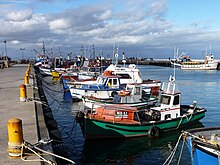Kalk Bay
| Kalk Bay | ||
|---|---|---|
|
|
||
| Coordinates | 34 ° 8 ′ S , 18 ° 27 ′ E | |
| Basic data | ||
| Country | South Africa | |
| Western cape | ||
| metropolis | City of Cape Town Metropolitan Municipality | |
| ISO 3166-2 | ZA toilet | |
| Residents | 700 (2011) | |
| founding | 1742 | |
| Website | kalkbay.org (English) | |
|
Kalk Bay
|
||
Kalk Bay (also: Kalkbay ; Afrikaans : Kalkbaai ) is a fishing village on False Bay and a suburb of Cape Town in the South African province of Western Cape . In 2011 it had 700 inhabitants. The village got its name because quicklime was produced here in kilns in the 18th century , which was an important raw material for building houses in the Cape area. The quicklime was used in particular in Bo-Kaap , a district of Cape Town predominantly inhabited by Muslims, to plaster houses with it. The lime was obtained from mussel shells that were found in large quantities on the beach.
history
The port of Kalk Bay first gained in importance in 1742 when the Dutch East India Company decided to use the neighboring town of Simon's Town as a winter anchorage for their fleet. Since there was no road connection between Cape Town and Simon's Town at that time, the goods that were necessary to maintain the fleet and expand the village were delivered by ox carts to Kalk Bay, where they were loaded onto boats, and then shipped to Simon's Town become. On the return trip to Cape Town, the ox carts transported lime and fish to Cape Town. When the Cape became a British colony in 1795, the new government built a road to Simon's Town that was easy to drive, so that the port of Kalk Bay lost its importance.
From 1820 whaling caused a brief upswing, which came to an abrupt end when the whale species southern right whale was almost extinct in False Bay around 1835. In 1840 a Filipino ship crew settled in Kalk Bay after their ship sank in False Bay, and from then on they made their living by fishing. Over the years, the Filipino fishing community has grown. Many of their descendants still live in Kalk Bay today. The train connection to Cape Town in 1883 changed the small fishing village. Now that it was possible to work in Cape Town and live in Kalk Bay, many new houses were built and the population increased.
The Filipino fishermen survived the Group Areas Act of apartheid in 1950 and were not resettled to the townships of Cape Town like other “non-whites” . The overfishing of False Bay, which has increased steadily since 1955, later deprived many of their livelihoods.
economy
Fishing is still an important source of income. However, it is no longer operated as intensively as it was in the middle of the 20th century. Since the train connection to Cape Town, tourism has become more and more important.
Attractions
Today, Kalk Bay is best known to tourists and locals as a charming and trendy coastal village. Kalk Bay has many antique shops, art galleries, fashion boutiques, jewelry stores, and restaurants. There are large sandstone caves in the mountains above the village.
The Kalk Bay Reef is known to surfers for its big waves, especially when there is strong northwest wind. Between July and November, southern right whales and humpback whales can be seen off the coast of Kalk Bay .
traffic
Kalk Bay is on the M4 Motorway. The place has a train station on the Southern Line of the Cape Town Metrorail .
Web links
- Website of Kalk Bay (English)
Individual evidence
- ↑ 2011 census , accessed November 20, 2013



